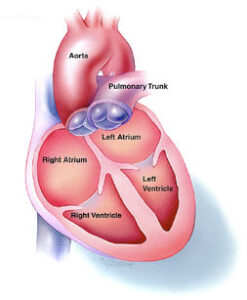| he Four Chambers of the Heart:
|
|
 |
Two upper chambers (the atria) are holding areas for blood returning from the body and lungs. The atria pump the blood into the lower chambers. |
 |
The two lower chambers (ventricles) pump blood back to the lungs and body. |
| Valves in the heart open and close to keep blood flowing in only one direction each time the heart beats. Each valve has a set of flaps (also called leaflets or cusps). Pressure across the valves causes them to open and let the blood flow through.
After the ventricles receive blood from the atria, valves close so blood does not flow backward into the atria. Other valves keep blood from flowing back into the ventricles after it is pumped into the lungs and body. |
The two sides of the heart have distinct functions. The right side receives blood from the body and pumps it to the lungs where it releases carbon dioxide and is enriched with oxygen. From the lungs, blood passes to the left side of the heart to be pumped to the body.
There are four heart valves:
The
tricuspid valve is located between the right atrium (upper chamber) and right ventricle (lower chamber).
The pulmonary or
pulmonic valve is between the right ventricle and the pulmonary artery (the main blood vessel of the lungs).
The
aortic valve is between the left ventricle and the aorta (the main blood vessel leading from the heart).
The
mitral valve separates the left atrium from the left ventricle.


